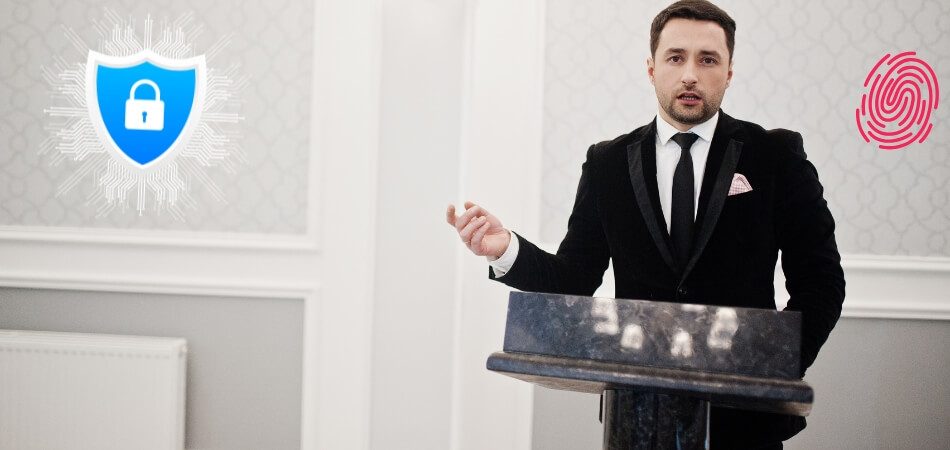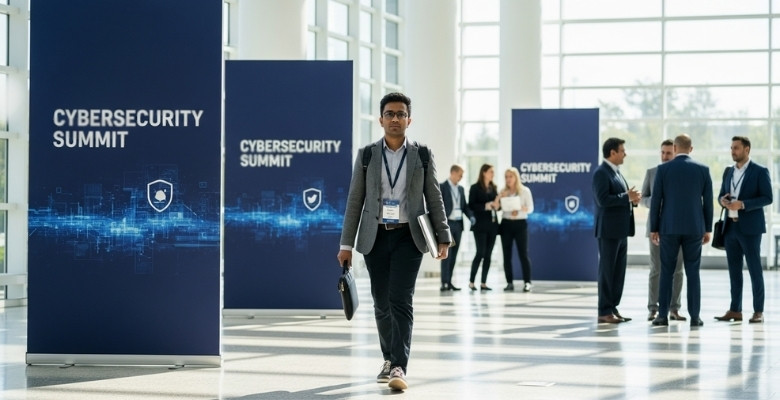Cyber security conferences bring together experts, learners, and professionals from all over the world. The halls are filled with talks, networking, and workshops. Many people heading to these events also start thinking about small details, like what do you wear to a cybersecurity conference.
Wear business casual to a cybersecurity conference. Pair chinos or dark jeans with a polo, blouse, or button-down. Add a blazer for formal sessions. Wear comfortable shoes for walking. Pack a light jacket for cold venues. Adjust your style based on the event—DEF CON is casual, RSA prefers polished attire.
Are you wondering how to dress if you are attending different events, speaking on stage, or traveling to venues across countries? If yes, then keep reading this article because it shares all the necessary details you need about clothing choices for cybersecurity conferences.
What Do You Wear to a Cybersecurity Conference?
Cybersecurity conferences often bring to mind the people you’ll meet, the sessions you’ll attend, and the overall atmosphere of the venue. One detail that many overlook, however, is what cybersecurity dress code. Dressing appropriately makes the event more comfortable and enjoyable, so let’s go through some simple tips.

Business Casual
Most cybersecurity conferences lean toward business casual. You can pair chinos or dark jeans with a polo shirt or button-down. A simple dress or blouse works fine too. If you want to look more polished, bring along a blazer. Some people wear suits, and that is also fine, especially if you prefer a sharper look. The main idea is to stay neat without being too formal.
Comfortable Shoes
You will likely spend hours moving between sessions and workshops. This means your shoes are the most important part of your outfit. Avoid brand-new dress shoes that can give you blisters. Instead, go with comfortable and broken-in shoes that you trust for long walks. Even big events like Black Hat and RSAC emphasize that comfy footwear is a must, so plan wisely.
Layering Clothes
The temperature inside big conference halls can be very different from the weather outside. Rooms may feel chilly due to air conditioning, while the outdoors might be warm. To handle this, pack a light sweater or jacket. Layering lets you adjust quickly so you are not freezing in one spot and sweating in another. This trick keeps you comfortable all day long.
Stepping it Up
When you know you will be speaking, attending interviews, or meeting with company executives, consider dressing a bit more formally. Adding a blazer or even wearing a full business suit will give a polished and professional look. While business casual works most of the time, stepping it up for special meetings shows extra respect and leaves a good impression on others.
RSA Conference
For the RSA Conference, business casual is the usual dress code. Attendees are expected to look professional yet not overly formal. Keeping your conference badge visible at all times is also important. One simple rule here is to avoid clothing with offensive text or images. The event values respect and professionalism, so staying clean, simple, and modest is the safest choice.
Black Hat Style
You will notice a wide mix of styles at Black Hat. Some people wear t-shirts and jeans, while others come in blazers. The event welcomes different clothing choices, but the one rule everyone agrees on is footwear. Since the venue requires a lot of walking, comfortable shoes are considered essential. If you focus on staying comfortable, you will fit in no matter which style you choose.
DEF CON Vibe
DEF CON is much more relaxed compared to other events. Expect to see hoodies, t-shirts, and even shorts. The atmosphere is casual, and nobody expects formal dress. Just remember, you will still be moving between warm outdoor spaces and cold indoor halls, so packing both light clothes and a sweater helps. Walking is a big part of this event too, so practical footwear is key.
Packing Checklist
Packing light but smart makes travel easier. You should include one or two smart tops and one or two casual tops. A pair of chinos or dark jeans is enough. Comfortable shoes plus a spare pair of socks are essential. Bring along a light sweater or jacket for layering, and if you plan to attend talks or interviews, add a blazer. This small list covers almost every situation.
Conference Location
What you wear can also depend a little on the city where the event is hosted. For example, if you are attending something like the upcoming Cyber Security Conference Canada, the USA, or any other country, you might want to check the local weather before packing. Some cities can be chilly even in warmer months, so planning your layers around the climate makes everything easier and keeps you comfortable through the event.
Dressing for a cybersecurity conference is really about balance. You want to look neat but also stay comfortable through long days. Focus on business casual, wear shoes you can trust, and be ready for changing temperatures. Simple planning makes all the difference.
Should You Consider the Venue When Choosing Your Outfit?
The place of an event often shapes the way people choose clothes. Each type of venue comes with its own tone and style rules. Picking the right outfit depends a lot on where you are going. Let’s see how venues can influence your outfit choices.
Hotel Events
Many hotels give a sense of formality and sophistication for gatherings. When attending such events, choosing neat and elegant outfits always works well. Smart suits, professional dresses, or polished casual looks usually fit perfectly. Comfort should still matter, but looking sharp is very important here.
Convention Centers
Large convention halls are usually buzzing with movement and activities all day. This makes practical and comfortable clothing a smart choice for visitors. Simple business casual looks often work best, including neat shirts or dresses. Since walking is common, supportive shoes can make a huge difference.
University Campuses
Programs or events on campuses often carry a friendly and relaxed environment. A tidy casual style usually feels most natural in such places. Neat jeans with a shirt or a light dress fit well. The aim is to appear respectful and suitable without looking too formal.
Indoor vs Outdoor
Venues inside offer controlled environments where dressing can focus on style. Outdoor locations depend a lot on the weather and the comfort of clothing. Layering works for uncertain conditions, while breathable fabrics handle hot days well. Sturdy footwear helps when moving across grass, stone paths, or uneven ground.
Venue Atmosphere
Different locations naturally set their own style expectations for visitors. Paying attention to this helps people avoid feeling awkward or misplaced. Outfits that suit the atmosphere always leave a better impression on others. Respecting the tone of the venue makes dressing choices much more successful.
The type of venue always affects how your outfit is received. Dressing for the setting shows respect and awareness of the event. Proper clothing choices also make you feel confident and very comfortable. Keeping the place in mind ensures your outfit never feels out of place.
How Important Are Comfortable Shoes at a Cybersecurity Conference?
People spend hours moving between sessions at a big conference, meeting halls, and networking areas. The focus is usually on the talks and events, but one small detail can make a huge difference. Let’s look at why shoes matter so much.
Long Hours Standing
Conferences usually last all day, often from early morning to evening. Most of the time is spent standing in long lines, waiting for talks, or speaking with people in crowded areas. If shoes are not supportive, this constant standing can quickly lead to sore feet, back pain, and low energy. Comfortable shoes help you stay fresh and active throughout the day.
Walking Between Venues
Large conference centers often require a lot of walking to get from one session to another. Sometimes events are spread across multiple floors or even different buildings. This constant movement can put extra pressure on your feet. With supportive shoes, walking long distances feels easier and less tiring, making it possible to attend more sessions without discomfort.
Networking Comfort
Conferences are not just about listening to speakers. They are also about meeting new people, having quick chats, and building useful connections. If your feet hurt, you may end up sitting out or leaving early. Comfortable shoes allow you to walk around with confidence, join conversations, and enjoy networking without being distracted by pain.
Focus and Energy
When your feet are uncomfortable, it’s hard to stay focused on talks and discussions. Pain and fatigue take away your attention, making it difficult to fully enjoy or remember what’s being shared. Good shoes help maintain energy and reduce stress, so you can give your best attention to every session.
Style and Practicality
While comfort is key, style also matters. Conferences often have a professional environment, so you’ll want shoes that look neat but also feel good. Thankfully, there are many modern options that balance both. Picking the right pair helps you look professional and stay comfortable at the same time.
Comfortable shoes may not seem like a big deal, but they are one of the most important choices for enjoying a long and busy conference. The right footwear helps you stay active, focused, and ready for every part of the event.
Should You Dress Differently for Speaking vs. Attending?
Conference settings often highlight how much your outfit influences first impressions, but the role you take part in also shapes expectations. Speakers, guests, and professionals each bring a different style. Let’s explore how these roles affect the way you dress and why choosing the right approach leaves a lasting impact.
Speaker Focus
When standing on stage, speakers naturally draw all eyes to them. Their clothing becomes part of the impression they leave. Speakers often stick closer to the expected cyber security conference dress code, aiming for polished and professional looks that set them apart from attendees. This might include tailored blazers, formal shoes, or subtle accessories.
Attendee Style
Most attendees prefer business casual because it keeps them comfortable while looking sharp. Chinos or jeans with a button-down shirt or blouse are common picks. Some like adding a blazer for a smarter look, while others stay casual depending on the event vibe. Comfort plays a big role here.
Stage Presence
Being on stage means photographs, recordings, and bright lights. Clothes that look neat in person may appear different under lighting. That’s why many speakers go for simple, solid colors and avoid distracting prints. It helps the audience focus on their message rather than their outfit.
First Impressions
Speakers often meet with organizers, sponsors, and media before or after their talks. Dressing more formally can give them extra confidence and help make a strong first impression. Meanwhile, attendees can relax more with their choices, since networking often happens in casual settings.
Comfort Balance
Even for speakers, comfort cannot be ignored. Long events require moving between sessions, standing for hours, and handling crowds. Good shoes, breathable fabrics, and layered outfits matter. This balance of style and comfort helps speakers and attendees get the most out of the conference.
Dressing for a conference depends on your role. Speakers lean formal for presence and impact, while attendees choose comfort with a smart touch. Either way, being prepared helps you feel confident and ready for the event.
Do Travel and Cultural Differences Affect What You Wear at U.S. Cybersecurity Conferences?
When traveling to a large event in another country, many people wonder what clothing works best. Comfort, professionalism, and local culture all play a part. Attendees from different regions often have different habits. Let’s look at some useful points to remember.
Local Dress Norms
Most cybersecurity conferences in the United States encourage a smart-casual style. People often wear neat shirts, blouses, or polos paired with comfortable trousers or jeans. Suits are less common unless it is a formal opening or networking dinner. Dressing simply but professionally helps you fit right in.
International Guests
Some international guests preparing a visa for cyber security conference in the USA also ask if local dress expectations differ from those in Europe or Asia. In many cases, they do. For example, European guests may be used to more formal clothing, while U.S. events often lean toward relaxed but tidy styles.
Weather Considerations
The U.S. is a big country with many climates. A conference in Las Vegas will feel very different from one in Washington, D.C. Checking the weather before packing helps you choose lighter or warmer clothes. Comfortable shoes and layers are always a good idea.
Cultural Impressions
How you dress at a conference can also influence first impressions. In the U.S., being approachable and easy to talk to is important. Wearing overly formal clothing may create distance, while overly casual outfits can look unprepared. Balanced clothing helps you connect better with others.
Practical Packing
Since travel often involves long flights and busy schedules, it’s smart to pack versatile pieces that can work for both casual sessions and evening events. Neutral colors, lightweight fabrics, and wrinkle-resistant clothing are helpful choices. This makes it easier to look neat without carrying too much luggage.
Travel and cultural differences do play a role in how you dress for U.S. cybersecurity conferences. Knowing the local style and preparing wisely ensures you stay comfortable, professional, and ready to enjoy the full event experience.
FAQs About What Do You Wear to a Cybersecurity Conference?
When preparing for a cybersecurity conference, small details in clothing can make a big difference. People often ask practical questions about dressing for long days, networking, and different events. Here are some helpful FAQs that clear common doubts.
Can You Wear Accessories at a Cybersecurity Conference?
Yes, but it is best to keep them simple. A watch, a neat belt, or light jewelry works well. Avoid flashy or noisy accessories that can distract during meetings or talks. The goal is to look professional without drawing attention away from your presence.
Is Wearing Branded Clothing a Good Idea?
Wearing branded clothing is fine as long as it looks neat and not too loud. Avoid large logos or slogans that might feel distracting. A small logo on a shirt or jacket is usually acceptable. Keeping the style clean and modest helps you look professional.
Should You Carry a Bag or Backpack?
Yes, carrying a bag is smart because you may need to hold notebooks, laptops, or conference materials. Backpacks are common and practical, while messenger bags or totes also work. Choose one that is not too heavy and feels comfortable. It should match your outfit without looking messy.
Are Hats or Caps Acceptable Inside Conferences?
Most indoor conferences expect people not to wear hats or caps during sessions. However, some casual events may allow it. If you enjoy wearing one, save it for outdoor spaces or travel. Sticking to the general professional style helps you blend in better.
Do People Wear Ties at Cybersecurity Conferences?
Ties are not very common unless you are attending a formal dinner, speaking on stage, or representing a company in an official meeting. Most people skip ties for comfort. If you prefer one, a simple and classic style works best. It can add polish when needed.
What Fabrics Are Best for Conferences?
Breathable fabrics like cotton, blends, and light wool are good choices. They help you stay comfortable through changing temperatures. Wrinkle-free fabrics are also useful because they keep you looking neat after hours of sitting or walking. Choosing the right fabric makes your day much easier.
How Many Outfits Should You Pack?
It depends on how long the event lasts. For a three-day conference, two business casual outfits and one slightly formal outfit are usually enough. You can reuse bottoms like jeans or chinos with different tops. Packing light but smart makes traveling simple.
Can You Wear Company-Branded Shirts?
Yes, many professionals wear shirts with their company’s logo. It shows team pride and makes it easy for others to recognize you. Just make sure the shirt is clean, neat, and fits well. Avoid wearing the same branded shirt every single day.
Should You Dress Differently for Networking Events?
Yes, networking events held in the evening may feel a bit more formal. A blazer, a smart dress, or neat shoes can help you look sharper. Even if the main sessions are casual, networking spaces often need a slightly polished touch. Dressing up shows effort and respect.
Is It Okay to Wear Casual Clothes During Travel Days?
Yes, casual clothes are fine while traveling to or from the conference city. Many people change into more professional outfits once they arrive at the event. Comfortable travel clothes help you stay relaxed on flights or long drives. Just keep one neat outfit ready for check-in or quick meetings.
Conclusion
Cybersecurity conferences are about more than just talks and tech sessions. How you dress plays a small but important role in how your day goes. Wearing the right clothes helps you feel more relaxed, comfortable, and ready for anything that comes your way.
So, what do you wear to a cybersecurity conference? The best choice is business casual with comfy shoes and light layers. You should look neat but also be able to move easily through sessions and venues without stress or discomfort.
Before you pack, check the weather, think about your role, and keep it simple. Try not to overpack and make sure your shoes are ready for long walks. Stay confident, enjoy the experience, and all the best for your upcoming conference!








